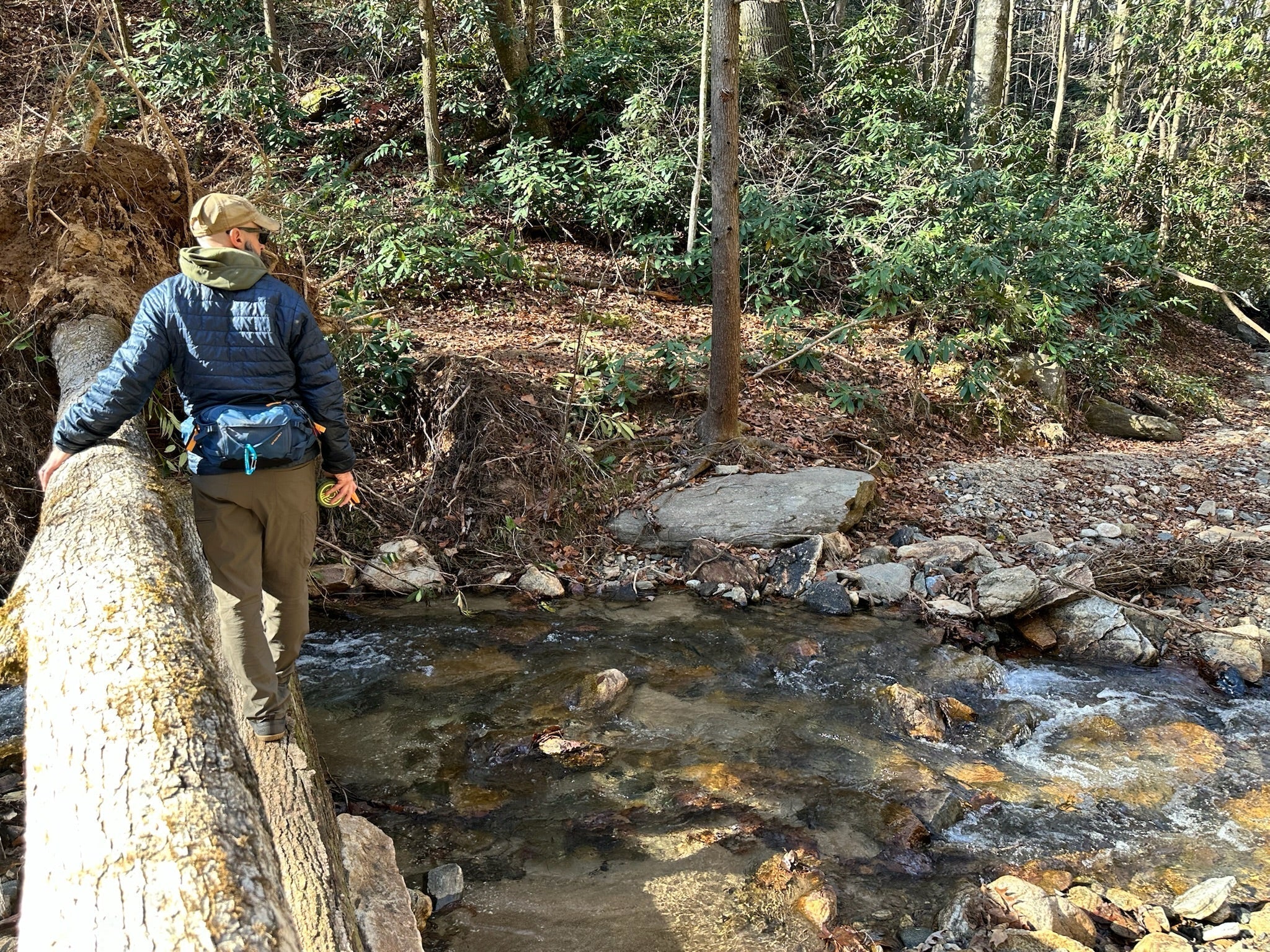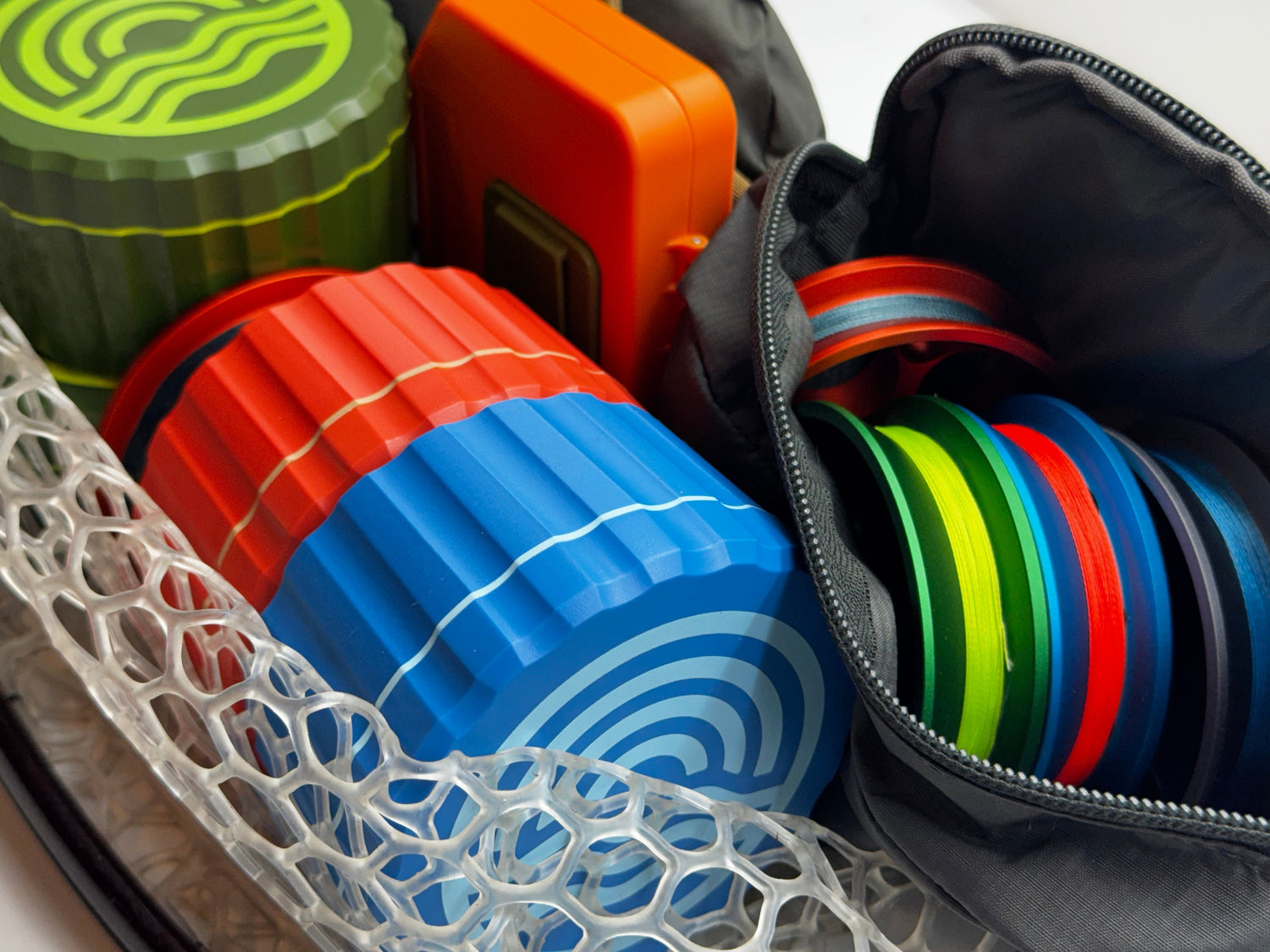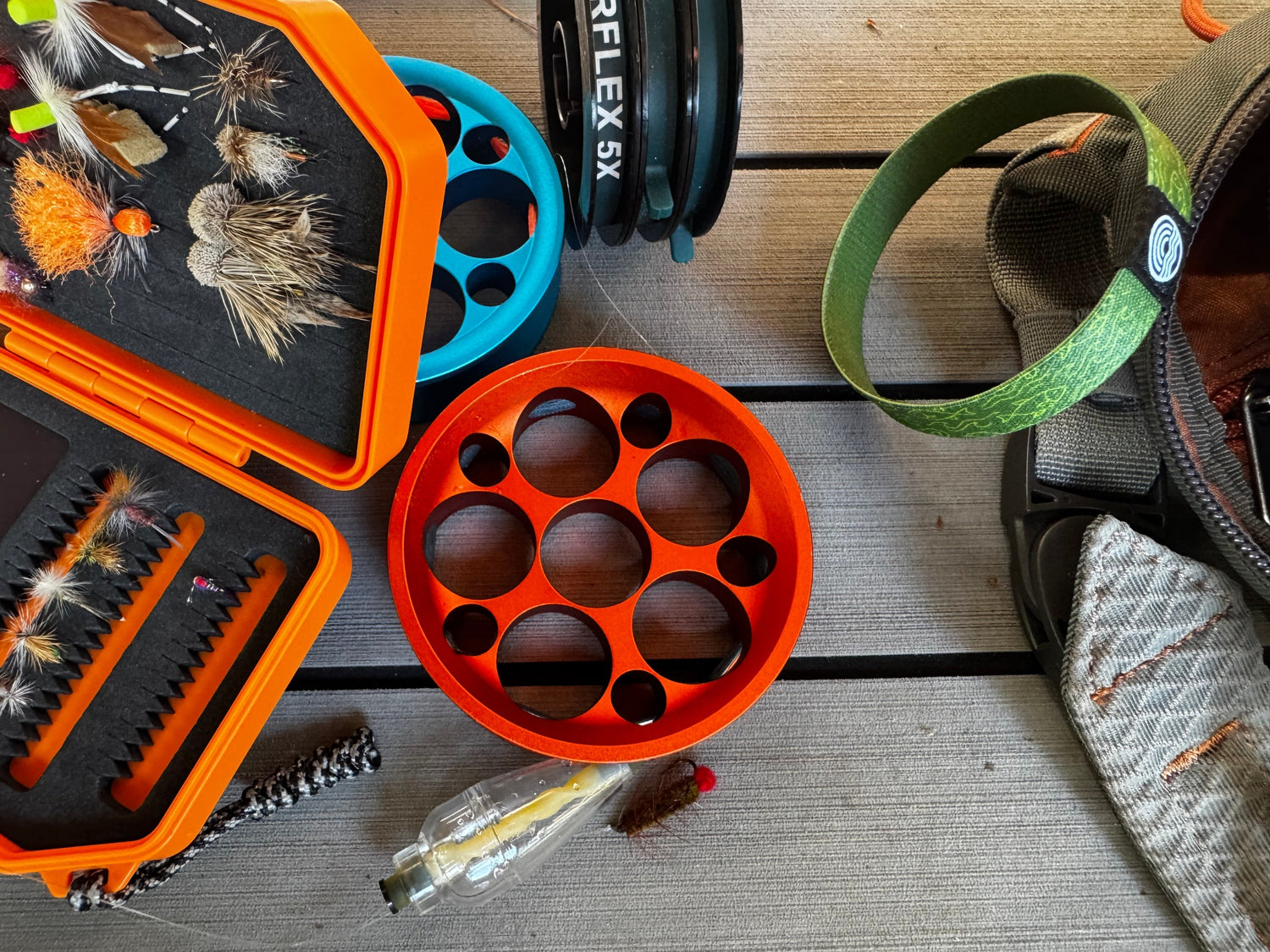The Perfect Combination: Hiking and Fishing with Minimal Gear
There's something magical about standing beside a remote mountain stream that few anglers ever reach, casting into pristine waters while surrounded by nature's grandeur. For outdoor enthusiasts who love both trail and water, combining hiking and fishing creates an experience greater than the sum of its parts. But traditional fishing gear—with its bulky rods, heavy tackle boxes, and fragile components—has long been the limiting factor in this perfect outdoor pairing.
Enter the GoReel: the innovative hand reel system that's revolutionizing how hikers approach fishing. As Mike McKearin, founder of Crystal Creek Gear and avid Western North Carolina angler explains, "I created the GoReel after years of frustration trying to bring conventional fishing gear on hiking trips through Pisgah and DuPont. I wanted something that wouldn't compromise my mobility on the trail but would still deliver a genuine fishing experience when I reached those hidden mountain pools."
This comprehensive guide explores how to seamlessly integrate GoReel fishing into your day hikes, opening up new dimensions of outdoor adventure without weighing you down or complicating your journey.
Why Combine Hiking and Fishing?

Before diving into the how-to aspects, let's consider why this combination is worth pursuing:
Access to Untapped Waters
"The best fishing spots are often the ones farthest from parking lots," says McKearin. "When you're willing to hike a few miles in, you'll find waters that see a fraction of the fishing pressure compared to easily accessible locations."
Statistics support this wisdom—a recent outdoor recreation survey found that 78% of anglers rarely venture more than a half-mile from their vehicles when fishing. By combining hiking with fishing, you immediately separate yourself from the majority of fishing pressure.
Efficiency in Outdoor Adventure
Time in nature is precious. By combining two complementary activities, you maximize your outdoor experience. A five-mile hiking loop that includes three fishing stops creates a varied adventure that engages different skills, muscles, and mental states throughout the day.
Mental and Physical Benefits
The rhythmic movement of hiking paired with the focused stillness of fishing creates a perfect balance for mind and body. Hiking elevates your heart rate and provides cardiovascular benefits, while fishing offers moments of mindfulness and presence. Together, they create a natural interval training for both physical and mental wellbeing.
Environmental Connection
When you move through landscapes on foot and then interact with their waters, you develop a deeper understanding of entire ecosystems. You'll begin noticing how elevation changes affect water temperature, how tree cover influences insect activity, and how watershed dynamics impact fish behavior—connections that might be missed when driving between fishing spots.
The Challenge of Traditional Fishing Gear for Hikers
Anyone who has attempted to bring conventional fishing equipment on a hike has encountered these common challenges:
Weight and Bulk Issues
Even "travel" fishing rods typically weigh 2-4 pounds when combined with reels and necessary tackle. Add this to an already-loaded day pack, and you're significantly increasing your burden on the trail.
Vulnerability to Damage
Traditional rods are prone to snagging on branches, breaking during falls, or being damaged when navigating tight spaces on trails. Many hikers have experienced the frustration of carrying fishing gear for miles only to have it damaged before even reaching the water.
Setup Time
Assembling multi-piece rods, threading line through guides, and preparing tackle can consume precious daylight minutes—especially problematic when you're making multiple short fishing stops along a hiking route.
Limited Versatility
Different water bodies often require different fishing approaches. Carrying equipment versatile enough for both small mountain streams and alpine lakes usually means more weight and complexity.
The GoReel Solution for Hiking Anglers
The GoReel hand reel fishing system addresses these challenges through innovative design and minimalist philosophy:
Ultralight and Compact
"When we designed the GoReel, weight was a primary consideration," McKearin notes. "At just 3.2 ounces for the standard model, it's literally lighter than a smartphone and takes up less space than a sandwich in your pack."
This ultralight profile means you can add fishing capability to your hiking kit with negligible weight penalty—crucial for maintaining hiking performance and comfort.
Virtually Indestructible
Unlike fragile graphite or fiberglass rods, the GoReel's injection-molded construction can withstand the rigors of trail life. It can be dropped on rocks, compressed in a pack, or exposed to elements without concern for damage.
"I've watched hikers baby their expensive collapsible rods on trails," McKearin says. "With the GoReel, that anxiety disappears. It's one less thing to worry about when you're navigating difficult terrain."
Instant Deployment
The GoReel requires no assembly, meaning you can transition from hiking to fishing in seconds rather than minutes. When you spot a promising pool while hiking, you can be casting within moments—maximizing fishing time during brief stops.
Adaptable to Various Waters
The GoReel system works effectively in diverse water environments encountered during hikes:
- Tight, brush-lined mountain streams where long rods are a liability
- Open alpine lakes where distance casting is needed
- Small beaver ponds where precision placement is critical
- Roadside rivers where quick access is valuable
This adaptability means one compact system serves multiple fishing scenarios you'll encounter along your hiking route.
Essential Gear for the Hiking Angler

Building on the foundation of the GoReel, here's the optimal gear setup for combining hiking and fishing:
The Core GoReel Kit
Start with the environment-specific GoReel kit that matches your hiking destination:
- River Kit: Ideal for mountain streams and moving water in places like Pisgah National Forest
- Lake Kit: Perfect for alpine lakes and larger still waters
- Pond Kit: Optimized for smaller still waters and beaver ponds
Each kit includes the appropriate line, terminal tackle, and lures for that environment, minimizing what you need to carry.
Minimal Additional Tackle
Beyond the base kit, consider these ultralight additions:
- 2-3 additional lures appropriate for local species (stored in a small waterproof container)
- Extra tippet material
- Small pack of split shot weights for depth adjustment
- Compact pair of hemostats for hook removal
"The beauty of minimalist fishing is discovering how little you actually need," McKearin explains. "Most hikers are surprised to find they can fit a complete fishing system in a pocket."
Multi-Purpose Hiking Gear
Several standard hiking items serve double-duty for fishing:
- Polarized sunglasses: Essential for both trail visibility and spotting fish
- Pocket knife: Useful for trail emergencies and fishing tasks
- Bandana: Provides sun protection and can dry hands after handling fish
- Smartphone: Serves as camera, GPS, and fishing journal
Packing Strategy
Distribute fishing gear thoughtfully in your hiking pack:
- Keep the GoReel accessible in a side pocket or top compartment for quick access
- Store small tackle items in a waterproof container
- Use a lanyard or retractable gear tether to secure the GoReel when fishing near steep banks
Planning Your Hiking-Fishing Adventure

Successful integration of hiking and fishing requires strategic planning:
Research Trails with Water Access
The ideal hiking-fishing route provides:
- Multiple water access points along the trail
- Variety in water types (pools, riffles, runs)
- Reasonable distances between fishing opportunities (ideally 1-2 miles)
- Legal fishing access (always check regulations)
Resources for finding suitable trails include:
- National forest service maps with stream overlays
- Hiking apps that indicate water features
- Local fishing guides and forums
- Topographic maps showing blue lines (streams) intersecting trails
Timing Considerations
Plan your hike-fish adventure with these factors in mind:
- Seasonal timing: Match your trip to prime fishing seasons for target species
- Daily timing: Schedule fishing stops during prime feeding periods (often early morning and evening)
- Hiking pace: Allow extra time beyond normal hiking estimates to accommodate fishing stops
- Weather patterns: Consider how recent weather affects both trail conditions and water clarity
"I always plan to fish the furthest point of my hike during the prime feeding window," advises McKearin. "This might mean hiking quickly in the morning to reach a remote pool by mid-day, or timing an evening arrival at a lake known for sunset activity."
Permit and Regulation Awareness
Before setting out, verify:
- Fishing license requirements for your destination
- Special regulations for wild or native fish
- Seasonal closures or restrictions
- Catch-and-release requirements
- Specific tackle restrictions (some waters prohibit certain lure types)
Top Destinations for Hiking Anglers
While great hiking-fishing combinations exist nationwide, these Western North Carolina locations offer exceptional opportunities for GoReel anglers:
Davidson River Trail
- Moderate 4.2-mile trail paralleling one of NC's premier trout streams
- Multiple access points to different water types
- Wild and stocked trout populations
- Ideal for the GoReel River Kit
"The Davidson River Trail is my testing ground for new GoReel prototypes," McKearin shares. "It offers everything from tight, technical pocket water to more open pools, all within a beautiful forest setting."
- Easy 2.5-mile trail with frequent stream access
- Crystal clear waters allowing sight fishing
- Natural rock features creating perfect plunge pools
- Excellent for beginners combining hiking and fishing
Three Lakes Trail
- Moderate 4.5-mile loop connecting Lake Julia, Lake Dense, and Fawn Lake
- Diverse fishing opportunities in three distinct environments
- Bass, sunfish, and trout possibilities
- Perfect showcase for the versatility of the GoReel system
Wintergreen Falls Trail
- Easy 3-mile out-and-back trail
- Multiple stream crossings with fishing potential
- Culminates at scenic waterfall with deep pool below
- Ideal half-day adventure combining hiking and fishing
Techniques for Fishing During Hikes
Effective fishing during hikes requires adapting techniques to maximize efficiency:
Quick-Scouting Approaches

Unlike dedicated fishing trips where you might spend hours analyzing a stream, hiking-fishing requires rapid assessment:
- Spend 30-60 seconds observing water before casting
- Look for obvious structure: undercut banks, large rocks, fallen trees
- Note water clarity, speed, and depth
- Watch for rising fish or other activity
- Make 5-10 casts to likely holding areas before moving on
"I use the 'three and move' rule when fishing during hikes," McKearin explains. "If I haven't had interest after three well-placed casts to a promising spot, I move on rather than lingering. This keeps the hiking rhythm while still giving me fishing opportunities."
Efficient Casting Methods with the GoReel

The GoReel's unique design enables several casting techniques ideal for trail-accessed waters:
- The Flick Cast: Perfect for tight quarters and brush-lined streams
- The Pendulum Cast: Ideal for reaching across wider pools
- The Roll Cast: Effective when backcast space is limited by trees
Practice these techniques before your trip to maximize fishing time on the trail.
Species Targeting Based on Water Types
Adjust your approach based on the water bodies you encounter:
- Mountain streams: Focus on pools and pocket water for trout, using natural drift techniques
- Alpine lakes: Target shoreline structure and drop-offs for trout and char
- Beaver ponds: Work edges and openings in vegetation for brook trout and panfish
- Larger rivers: Concentrate on seams between fast and slow water for larger trout and smallmouth bass
Time Management Between Hiking and Fishing
Balance is key to a successful combination adventure:
- Set a timer for fishing stops to avoid losing track of time
- Establish a maximum number of casts per location
- Consider the "fish or move on" decision point after 15-20 minutes
- Reserve longer fishing sessions for the most promising or remote locations
Safety Considerations for Hiking Anglers
Combining activities requires additional safety awareness:
Essential Safety Gear
Beyond standard hiking safety equipment, consider:
- Packable wading staff for stream crossings
- Non-slip footwear suitable for both trail and wet rocks
- Quick-dry clothing layers
- Waterproof container for phone and essentials
Weather Awareness
Water conditions can change rapidly in mountain environments:
- Check weather forecasts for the specific area you'll be hiking
- Be alert for afternoon thunderstorms common in mountain regions
- Understand how rainfall affects stream conditions and safety
- Have clear criteria for when to abandon fishing due to weather changes
Solo vs. Group Considerations
"I approach solo hiking-fishing differently than group outings," notes McKearin. "When alone, I'm more conservative about stream crossings and water access points. With a group, we can spot each other and manage risks more effectively."
If fishing solo:
- Inform someone of your specific route and expected return time
- Consider using a GPS tracking device
- Be more conservative in your risk assessment
- Carry a compact first aid kit accessible without removing your pack
Environmental Responsibility
The hiking angler has special responsibilities as a dual-use outdoor enthusiast:
Leave No Trace Principles
Apply Leave No Trace ethics rigorously:
- Pack out all fishing materials, including line trimmings and packaging
- Stay on established trails when hiking between fishing spots
- Minimize streambank erosion by using existing access points
- Leave rocks and woody debris in place (they're crucial fish habitat)
Proper Fish Handling

The GoReel's minimalist approach pairs naturally with conservation-minded fishing:
- Use barbless hooks for easier release
- Wet hands before handling fish
- Keep fish in the water when removing hooks when possible
- Revive fish thoroughly before release
- Consider carrying a small fishing net with rubber mesh to minimize fish handling
Minimizing Impact on Riparian Zones
The transitional areas between land and water are ecologically crucial:
- Avoid trampling vegetation along banks
- Cross streams at designated crossings when possible
- Don't clear brush or branches for casting access
- Be especially careful in headwater areas where ecosystems are most fragile
"The GoReel was born partly from environmental concern," McKearin explains. "I wanted to create a fishing system that would have minimal impact on delicate mountain ecosystems while still allowing anglers to connect with these special places."
Real Experiences: Stories from Hiking Anglers
The combination of hiking and GoReel fishing has created memorable experiences for many outdoor enthusiasts:
Sarah's Family Discovery
Sarah M., a mother of two from Asheville, shares: "We've been hiking with our kids (ages 8 and 10) for years, but adding GoReel fishing to our outings has completely changed the dynamic. The kids used to complain about 'just walking,' but now they're excited to reach the next stream crossing or lake. My daughter caught her first-ever fish on a GoReel during a hike at DuPont State Forest, and it's become a core memory for our family."
James' Unexpected Success
James T., an experienced backpacker, reports: "I was skeptical about hand reel fishing until a friend convinced me to pack a GoReel on our three-day trip along the Foothills Trail. On day two, we hit a remote section of the Chattooga River that rarely sees anglers. Using the GoReel, I landed a 19-inch brown trout—my personal best—on gear that added only a few ounces to my pack. I'm now a complete convert to the hiking-fishing combination."
Seasonal Considerations
Each season offers unique opportunities and challenges for the hiking angler:
Spring
- Focus on lower elevation trails as higher elevations may still have snow
- Be prepared for higher, colder water from snowmelt
- Target sunny afternoons when insect activity increases
- Watch for spring hatches, particularly caddis and mayflies
- Be mindful of seasonal closures protecting spawning fish
Summer
- Start early to beat both trail heat and to hit morning feeding windows
- Consider higher elevation trails where water stays cooler
- Bring sun protection for both hiking and fishing portions
- Focus on shaded sections of streams during midday heat
- Be prepared for afternoon thunderstorms common in mountain areas
Fall
- Take advantage of pre-spawn feeding frenzies for many species
- Enjoy less crowded trails as summer hikers diminish
- Be prepared for rapidly changing weather conditions
- Bring layers to stay comfortable during temperature swings
- Consider fishing during the warmest part of the day when insect activity peaks
Winter
- Focus on lower elevation trails and tailwaters that remain ice-free
- Fish during the warmest hours (typically 11am-3pm)
- Target slow, deep pools where fish conserve energy
- Be prepared with extra layers and hand warmers
- Consider shorter hiking routes with multiple fishing options
The Integrated Outdoor Experience
The combination of hiking and fishing represents more than just doing two activities in one outing—it's about creating an integrated outdoor experience that engages all your senses and skills. With the GoReel system, this integration becomes seamless, allowing you to move through landscapes and connect with waters in a way that traditional gear never permitted.
"What I love most about combining hiking and fishing with the GoReel is the freedom it provides," reflects McKearin. "Freedom from heavy gear, freedom to explore further, and freedom to experience water in its most natural state. When your fishing gear disappears into a pocket, the boundaries between hiking and fishing dissolve, and you're just experiencing nature in its fullest form."
Whether you're a dedicated angler looking to reach new waters, a hiker seeking to add dimension to your trail experiences, or an outdoor enthusiast wanting to maximize your time in nature, the hiking-fishing combination offers rich rewards. The GoReel makes this combination not just possible, but effortless.
The next time you lace up your hiking boots, consider slipping a GoReel into your pocket. Those blue lines crossing your trail map aren't just obstacles to cross—they're opportunities to discover the perfect harmony between path and pool, between movement and stillness, between hiking and fishing.





